At the Administrative Appeals Tribunal (AAT), we give individuals and organisations the opportunity to have administrative decisions independently reviewed. We review decisions made by Australian Government ministers, departments, and agencies. In limited circumstances, we review decisions made by state and territory governments and some non-government bodies.
The types of decisions the AAT most commonly reviews relate to:
- Australian citizenship
- child support
- family assistance and social security
- migration and refugee visas
- the National Disability Insurance Scheme
- taxation
- veterans’ entitlements
- workers’ compensation under Commonwealth laws.
We can also review a wide range of other decisions but only if the law the decision is made under states that it can be reviewed by the AAT.
We aim to make our review processes accessible, fair, just, economical, informal, quick and proportionate.
We manage our workload in 9 divisions:
- Freedom of Information (FOI) Division
- General Division
- Migration and Refugee Division
- National Disability Insurance Scheme (NDIS) Division
- Security Division
- Small Business Taxation Division
- Social Services and Child Support Division
- Taxation and Commercial Division
- Veterans’ Appeals Division.
The Hon Justice Emilios Kyrou AO, a judge of the Federal Court of Australia, leads the AAT as our President. The Tribunal consists of other members appointed as Deputy Presidents, Senior Members and Members. The President is responsible for managing the administrative affairs of the AAT with the assistance of Deputy Presidents, who are appointed as Division Heads, and the Registrar, Michael Hawkins AM.
We also host the Immigration Assessment Authority (IAA), a separate office within the Migration and Refugee Division, which provides a fast track review process in relation to certain decisions to refuse protection (refugee) visas.
Key caseload statistics
The AAT received 7% fewer applications in 2022–23 than in the previous reporting period, while finalising 2% more applications than in 2021–22. The number of applications on hand at 30 June 2023 was 2% lower than the number on hand at 30 June 2022.
The tables below show our key caseload statistics for 2022–23 and the preceding 7 years.
AAT caseload overview, 2015–16 to 2022–23
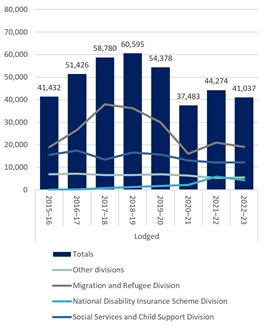
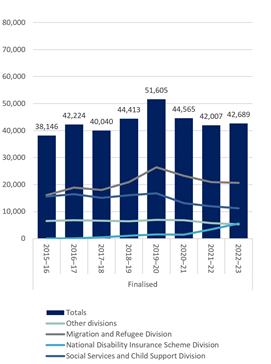
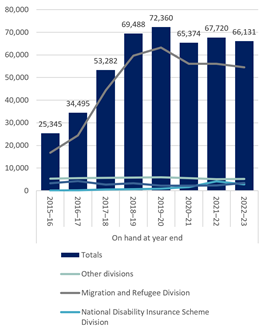
Applications lodged, finalised and on hand, 2022–23 – by division
|
DIVISION
|
LODGED
|
FINALISED
|
ON HAND AT YEAR END
|
|
No
|
% of total
|
No
|
% of total
|
No
|
% of total
|
|
Freedom of Information
|
143
|
<1%
|
75
|
<1%
|
165
|
<1%
|
|
General
|
3,937
|
10%
|
4,333
|
10%
|
2,587
|
4%
|
|
Migration and Refugee
|
19,050
|
46%
|
20,640
|
48%
|
54,575
|
83%
|
|
National Disability Insurance Scheme
|
4,271
|
10%
|
5,604
|
13%
|
2,846
|
4%
|
|
Security
|
2
|
<1%
|
7
|
<1%
|
31
|
<1%
|
|
Small Business Taxation
|
417
|
1%
|
193
|
<1%
|
688
|
1%
|
|
Social Services and Child Support
|
12,260
|
30%
|
11,162
|
26%
|
3,460
|
5%
|
|
Taxation and Commercial
|
791
|
2%
|
496
|
1%
|
1,607
|
2%
|
|
Veterans’ Appeals
|
166
|
<1%
|
179
|
<1%
|
172
|
<1%
|
|
TOTAL
|
41,037
|
100%
|
42,689
|
100%
|
66,131
|
100%
|
Our review processes vary according to the type of decision being reviewed, reflecting differences in legislative requirements as well as specific approaches developed to deal with the broad range of decisions that we review.
In the FOI, General, NDIS, Small Business Taxation, Taxation and Commercial, and Veterans’ Appeals Divisions, we use alternative dispute resolution (ADR) to help parties understand and narrow the issues in dispute, identify further evidence that will be gathered, and try to reach agreement about how their case could be resolved.
In 2022–23, we finalised significantly more applications with at least one ADR incident[RA1] than in the previous reporting year (an increase of 19% to 7,205 in the reporting period).
Applications to the AAT may be finalised in different ways. This reporting year, we finalised half of all applications by making a decision, usually after conducting a hearing. Other methods of finalisation are set out below.
Mode of finalisation applications for review of decisions, 2022-23
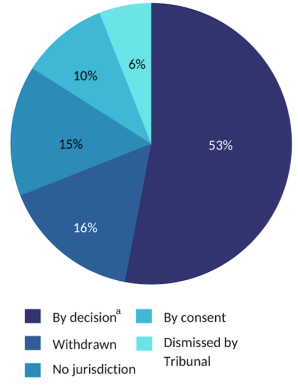
* ‘By decision’ includes applications finalised by a decision of the AAT on the merits under section 43 of the Administrative Appeals Tribunal Act or section 349 or 415 of the Migration Act. ‘No jurisdiction’ includes applications in relation to which the AAT cannot review the decision. ‘By consent’ includes applications finalised in accordance with terms of agreement reached by the parties.
Outcomes of applications for review of decisions 2022-23
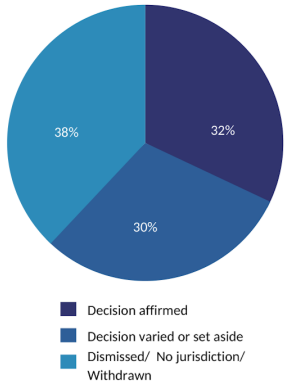
IAA key caseload statistics
The IAA received significantly fewer referrals in 2022–23 than in the previous reporting year. This reduction in referrals was mostly due to the introduction of Government policy that enables fast track temporary protection visa holders to be eligible to apply for permanent Resolution of Status visas.
In most cases, the IAA affirmed the decision under review (144 cases), with the decision remitted to the Department of Immigration for reconsideration in 28 cases.
|
REFERRALS
|
FINALISATIONS
|
ON HAND AT YEAR END
|
MEDIAN TIME TO FINALISE (WEEKS)
|
|
2021–22
|
906
|
1,077
|
41
|
7
|
|
2022–23
|
158
|
173
|
26
|
9
|
The top 5 countries of reference of referred applicants in 2022–23 were Sri Lanka, Iran, Iraq, Afghanistan and Pakistan.
Our performance
Number of finalisations
The number of cases finalised reflects the scale of activity undertaken by the AAT and IAA in carrying out our function of reviewing decisions. In 2022–23, we finalised a substantial number of applications and referrals, exceeding our target by 2 percentage points.
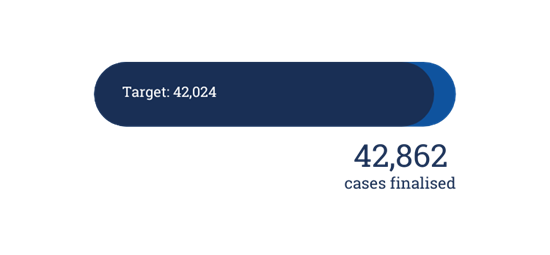
Clearance ratio
The clearance ratio is a measure of how many AAT applications and IAA referrals were finalised in the reporting year in relation to how many were received. This reporting year, we exceeded our clearance ratio target by 4 percentage points.
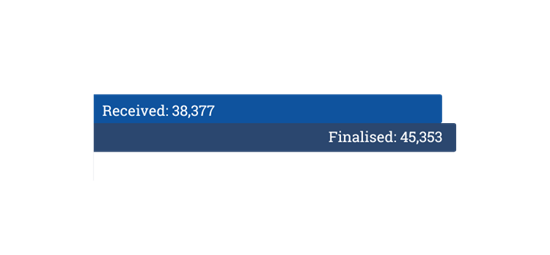
Timeliness
This measure is an indicator of the extent to which the AAT and IAA are providing a mechanism for a review that is quick. In 2022–23, we fell short of our overall target of finalising 75% of cases within 12 months of lodgement. This is primarily because we do not have the resources to address the large backlog of cases from increased demand for our services.

Publication of decisions
We publish statements of reasons for many of the decisions we make to promote public trust and confidence in our decision-making. We exceeded our 2022–23 target to publish at least 5,000 decisions, with 5,032 decisions published at the time of preparing our Annual Report. Our decisions are published on the Australasian Legal Information Institute website (www.austlii.edu.au).
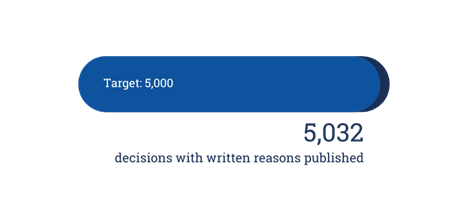
User feedback rating
The user experience rating measures the extent we provide a mechanism of review that is accessible, fair, informal and quick. During the reporting year, we surveyed our users for their views on a range of aspects and their perceptions of the process overall. Parties and representatives continue to rate our services positively with the AAT receiving a rating of 72% in our 2022–23 survey (exceeding our goal of 70%).

Judicial review outcomes
Our decisions may be appealed to the courts, and the appeal may be allowed if there was an error of law in relation to how the review was conducted or in reaching a decision. We aim to have fewer than 5% of appeals against our appealable decisions allowed by the courts. During the reporting year, 324 appeals of decisions made by the AAT and IAA were allowed against the number of decisions that could have been appealed. This was under target at 2.1%.
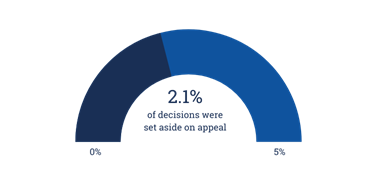
Key achievements in 2022–23
In December 2022, the Australian Government announced that the AAT will be abolished and replaced with a new federal administrative review body. Despite this complex environment, the AAT remained focused on providing high-quality merits review while supporting the Government’s reform process.
During the reporting year, we continued to provide review services in accordance with our statutory objectives, allowing a substantial number of people and organisations to exercise their right to challenge administrative decisions, and contributing to government accountability and transparency.
We also strengthened our digital operating environment leading to improvements in our efficiency. This work also lays the groundwork for our new case management solution, which is in development and will enhance our users’ experience of our digital services. Upgrades to our hearing room equipment and systems in some of our registries also improved access to the AAT for our users.
We progressed all actions in our Reflect Reconciliation Action Plan (RAP), which was launched in May 2022. Throughout the reporting year, we have laid important foundations for future reconciliation efforts by growing respectful relationships with First Nations peoples as Tribunal users, our members and staff, and as the suppliers who assist us to do our important work.
Our people are fundamental to the delivery of high-quality merits review. We ensured that members and staff are appropriately skilled to perform their work in 2022–23 by providing professional development and ongoing support. We also maintained our focus on the health and wellbeing of our members and staff, and on encouraging positive workplace cultures.
More detailed information about the AAT and our operations can be found in our 2022–23 Annual Report, available on the Australian Government Transparency Portal ((www.transparency.gov.au) and our website (www.aat.gov.au).